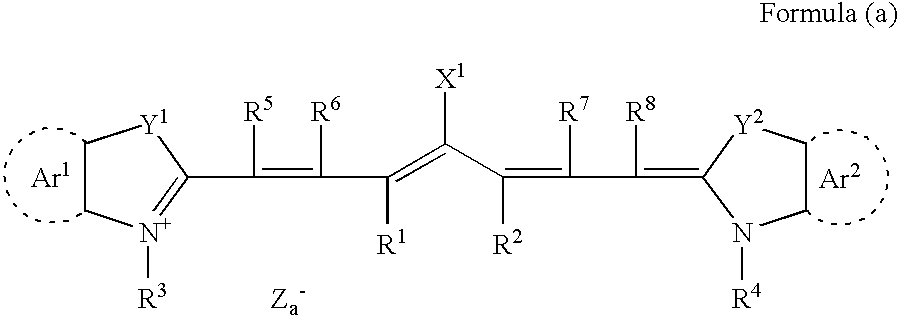Planographic printing plate precursor and pile of planographic printing plate precursors
a technology of planographic printing plate and precursor, which is applied in the field of negative-type planographic printing plate precursor, can solve problems such as inefficiency in the exposure step
- Summary
- Abstract
- Description
- Claims
- Application Information
AI Technical Summary
Benefits of technology
Problems solved by technology
Method used
Image
Examples
example 1
[0315]Preparation of Support
[0316]A JIS-A1050 aluminum plate having a thickness of 0.30 mm and a width of 1,030 mm was surface-treated as follows:
Surface Treatment
[0317]The surface treatment was carried out by sequentially conducting the following steps (a) to (f). After each step and water washing, liquid remaining on the aluminum plate was removed with a nip roller.
[0318](a) The aluminum plate was etched in a solution containing 26 weight % of sodium hydroxide and 6.5 weight % of aluminum ions at 70° C., until the amount of dissolved aluminum became 5 g / m2. The etched plate was then washed with water.
[0319](b) The aluminum plate was desmutted by spraying an aqueous solution including 1 weight % of nitric acid and 0.5 weight % of aluminum ions and kept at 30° C. to the plate. The aluminum plate was then washed with water.
[0320](c) The surface of the aluminum plate was continuously electrochemically roughened by applying an alternate current voltage having a frequency of 60 Hz to th...
examples 2 to 5
[0330]Planographic printing plate precursors of Examples 2 to 5 were obtained in the same manner as in Example 1, except that the kind of the silica-coated organic resin fine particles and the addition amount of the mica compound used to make the protective layer coating liquid in Example 1 were changed as shown in Table 1.
example 6
[0331]A recording layer was formed using the same recording layer coating liquid [P-1] as Example 1, thereafter the following protective layer coating liquid [2] was applied to the surface of the recording layer with a wire bar, and the resultant coating was dried for 75 seconds at 125° C. in a hot air drier to form a first protective layer.
[0332]The total coating amount (dry coating amount) of the protective layer was 0.5 g / m2.
Synthetic mica (SOMASIF ME-100 manufactured by94 gCo-op Chemical Co., Ltd., 8% aqueous dispersion)Polyvinyl alcohol (CKS-50: saponification degree of82 g99 mol %, degree of polymerization of 300, manufacturedby Nippon Synthetic Chemical Industry Co., Ltd.)Surfactant-1 (PLURONIC P-84, manufactured by BASF)2.5 g Surfactant-2 (EMALEX 710, manufactured by 5 gNihon-Emulsion Co., Ltd.)Pure water1384 g
[0333]Subsequently, the following protective layer coating liquid [3] was applied to the surface of the first protective layer with a wire bar, and the resultant coat...
PUM
| Property | Measurement | Unit |
|---|---|---|
| liquid temperature | aaaaa | aaaaa |
| particle diameter | aaaaa | aaaaa |
| particle diameter | aaaaa | aaaaa |
Abstract
Description
Claims
Application Information
 Login to View More
Login to View More - R&D
- Intellectual Property
- Life Sciences
- Materials
- Tech Scout
- Unparalleled Data Quality
- Higher Quality Content
- 60% Fewer Hallucinations
Browse by: Latest US Patents, China's latest patents, Technical Efficacy Thesaurus, Application Domain, Technology Topic, Popular Technical Reports.
© 2025 PatSnap. All rights reserved.Legal|Privacy policy|Modern Slavery Act Transparency Statement|Sitemap|About US| Contact US: help@patsnap.com



